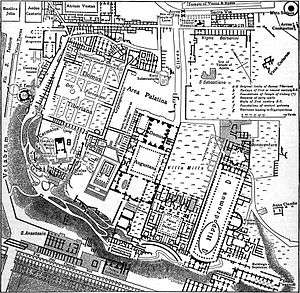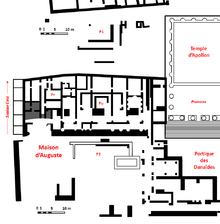House of Augustus
| Domus Augusti | |
|---|---|
 Fresco in the House of Augustus. | |
| Location | Palatine Hill |
| Type of structure | Domus |
| Related |
List of ancient monuments in Rome |
 Domus Augusti | |
The House of Augustus, or the Domus Augusti, is the first major site upon entering the Palatine Hill in Rome, Italy. Historically, this house has been identified as the primary place of residence for the emperor Augustus.[1] The Domus Augusti is located near the so-called Hut of Romulus and other sites that have connections to the foundation of Rome. This residence contained a complex of structures that were situated around the Temple of Apollo Palatinus.
The Domus Augusti should not be confused with the nearby Domus Augustana, part of the vast palatial complex constructed by Emperor Domitian on the Palatine in 92 CE.[2]

Excavations
In 1865, Pietro Rosa began excavations at what is now called the House of Livia. His excavations, part of a larger program commissioned by Napoleon III, included a superficial excavation of the Domus Augusti, located to the south. In 1937, Alfonso Bartoli did further surveys of the area and found archaeological remnants of collapsed vaults. [3] In 1956, extensive excavations began under Gianfilippo Carettoni. His initial excavations revealed a structure, consisting of a set of rooms, which has now been identified as part of a larger complex known as Peristyle A. He attributed this structure to Augustus based on its proximity to the nearby Temple of Apollo.[4] In the first decade of the 2000s, further work was done, which led archaeologists to posit that the original peristyle was part of a much larger house.[5] A restoration program, said to have cost almost two million euros, was completed in 2008, giving the public access to the rooms excavated by Gianfilippo Carettoni.[6]
Literary Evidence
The House of Augustus is heavily attested in ancient literary sources. Suetonius' work indicates that Octavian moved into the House of Quintus Hortensius on the Palatine, relocating from his original home in the Roman Forum.[7] Velleius reports that after, Octavian began to purchase the land surrounding House of Hortentius.[8] Soon after, this spot was struck by lightning, and so Octavian declared this a public property and dedicated a temple to Apollo, known as the Temple of Apollo Palatinus, as Apollo had helped Augustus in his victory over Sextus Pompey in 36 BCE.[9] And because of this pious act, as Cassius Dio states, the senate decreed that the property around this area should be given to Augustus from public funds.[10] The oak crown, said to have adorned the front door, was a tribute to this senatorial dedication in 27 BCE.[11][12] Suetonius speaks of it in the past tense, so it may be presumed that it burned during the fire of Nero.
The house was destroyed in a fire in 3 CE, but the rebuilt and made state property.[13][14]
Archaeological Evidence
The plan of the site consists of a series of rooms in sections built at various times, built from tufa blocks of opus quadratum. It has two peristyle style courts that are bordered by small rooms. The monument was two-stories, terraced complex. Between each peristyle sits the Temple of Apollo Palatinus. Most of the archaeological evidence that survives is derived from Peristyle A, as much of Peristyle B was destroyed by the later Palace of Domitian. This entire site occupies ca. 8,600 m².
Carrettoni House

Excavated and initially identified as the House of Augustus by G. Carettoni, this structure encompasses the northern rooms adjacent to Peristyle A. The structure consists of two rows of rooms built in opus quadratum, divided into an eastern and western section.
.jpg)
The rooms to the western side of this complex may have been designated as the private living quarters. These rooms consist of extensive wall decoration and paintings. One room, known as the Room of the Masks, features perspective architectural paintings and theatrical masks, typical of the Second Style of Roman wall painting. Another room features bows of pine, very similar to the House of Livia.[15] These two rooms date to 30 BCE.[16]
%2C_room_of_the_Pine_Festoon%2C_decoration_with_pilastered_portico_and_pine_festoons%2C_2nd_Pompeian_style%2C_Palatine_Hill%2C_Rome_(20062280583).jpg)
The eastern rooms encircled a large central room, which was open toward the south, and perhaps served a public function. These rooms were decorated with geometric floor mosaics.[17]
G. Carettoni, who identified the whole structure as the House of Augustus, attached it to the Temple of Apollo through an entranceway.[4] Recent excavations have shown that these rooms were filled in and partially destroyed in 30 BCE in order to build the Temple of Apollo Palatinus, and this entranceway has now been posited as a staircase to a second level instead.[18]
Irene Iacopi and G. Tedone suggest that this was part of the original house of Hortentius purchased by Augustus. After building a temple to Apollo, in which he destroyed some of these rooms, he reconfigured his villa, and built a large Peristyle (Peristyle A) and rooms overtop of the Carettoni house.[19] On the other hand, A. Carrandini and D. Bruno suggested that the Carretoni house and rooms were part of an earlier villa, that was incorporated into the later Peristyle.
Peristyle A
This peristyle sits just west of the Temple of Apollo. It dates to approximately 39 BCE and has been identified as the private quarters of the villa. There is little archaeological evidence that remains, with the exception of a portion of the tufa peristyle. [20]
Peristyle B
Scholars have suggested a symmetrical plan of the entire complex, in which a peristyle (Peristyle B) complex sits in a symmetrical position across on the other side of the Temple, and was constructed between 39 and 36 BCE. It perhaps served a public function.[21] However, there is little archaeological evidence to support this hypothesis, as the construction of the Palace of Domitian, also known as the Domus Augustana, has disturbed much of this area on the Palatine. It has been suggested by some scholars that this was how the Domus Augustana received its name.[22]
Temple of Apollo Palatinus
Initially identified as the Temple of Jupiter Victor, the Temple of Apollo Palatinus is located between both peristyles, on a higher terrace. It was finished in 28 BCE, confirmed by the findings of Republican houses underneath it. The podium was 24 m by 45 m, and the Temple featured barrel vaults and Corinthian capitals. Built of Luna marble and concrete, it housed the cult statues of Apollo, Diana and Latona, in addition to the Sibylline books.[23]
Issues of Identification
Suetonius (c. 70 CE – 130 CE), lawyer and secretary of the imperial palace, wrote of the House of Augustus:
It is generally agreed that he was most temperate and without even the suspicion of any fault. He lived at first near the Forum Romanum, afterwards on the Palatine in a modest dwelling remarkable neither for size or elegance, having but a short colonnade with columns of local stone and rooms without any marble decorations or handsome pavements. For more than 40 years he used the same bedroom in winter and summer.[24]
This modesty is also attested in Augustus' promotion of anti-sumptuary laws, where he placed limits on private building projects.[25] These literary accounts have ignited debates over the identification of this monument in recent years, and have called into question the identification of this complex as the House of Augustus. Carettoni, having only partially excavated the area, classified the structure as being restrained in elegance and decor.[4] Since further excavation revealed a very large villa plan, Andrea Carandini is inclined to doubt the statement of Suetonius.[26] Other scholars have instead suggested that this villa would have been too luxurious and large to be the House of Augustus that is described in the literary sources.[5][27]
See also
![]()
References
- ↑ Tomei, Maria Antonietta. The Palatine. Trans. Luisa Guarneri Hynd. Milano: Electa, 1998. Print.
- ↑ Richardson, Lawrence. "Domus Augstana" From A New Topographical Dictionary of Ancient Rome. Baltimore: Johns Hopkins UP, 1992. Print.
- ↑ Hall, Jonathan (2014). Artifact & Artifice: Classical Archaeology and the Ancient Historian. Chicago: University of Chicago Press. p. 168-170.
- 1 2 3 Carettoni, Gianfilippo (1967). "I problemi della zona augustea del Palatino alla luce dei recenti scavi". RendPontAcc (Rendiconti della Pontificia Accademia Romana di Archeologia) (in Italian). 38: 61–4.
- 1 2 Iacopi, I.; Tedone, G. (2006). "Bibliotheca e Porticus ad Apollinis". MDAI. 112: 352–5.
- ↑ Hall, Jonathan (2009). Artifact & Artifice: Classical Archaeology and the Ancient Historian. University of Chicago Press. p. 168.
- ↑ Suetonius. Life of Augustus 72.
- ↑ Velleius Paterculus. The Roman History. II. 81-3. English translation in Compendium of Roman History. Translated by F. W. Shipley. Harvard University Press. 1924. ISBN 9780674991682.
- ↑ Suetonius. Life of Augustus.
- ↑ Cassius Dio. Roman History 73.
- ↑ Ovid. Fasti I.
- ↑ Cassius Dio. Roman History 53.
- ↑ Suetonius. Life of Augustus 57.
- ↑ Cassius Dio. Roman History 55.
- ↑ Hall, Jonathan (2014). Artifact & Artifice: Classical Archaeology and the Ancient Historian. Chicago: University of Chicago Press. p. 176.
- ↑ Coarelli, Filippo (2014). Rome and Environs. London: University of California Press. p. 141.
- ↑ Coarelli, Filippo (2014). Rome and Environs. London: University of California Press. p. 140.
- ↑ Hall, Jonathan (2014). Artifact & Artifice: Classical Archaeology and the Ancient Historian. Chicago: University of Chicago Press. p. 181.
- ↑ Iacopi, Irene; Tedone, Giovanna (2006). "Bibliotheca e Porticus ad Apollinis". MDI. 112: 366-371.
- ↑ Carandini, Andrea; Bruno, Daniela (2008). La casa di Augusto dai "Lupercalia" al Natale. Rome: Laterza. p. 30-31.
- ↑ Carandini, Andrea; Bruno, Daniela (2008). La casa di Augusto dai "Lupercalia" al Natale. Rome: Laterza. p. 192-194.
- ↑ Coarelli, Filippo (2014). Rome and Environs. London: University of California Press. p. 142.
- ↑ Coarelli, Filippo (2014). Rome and Environs. London: University of California Press. p. 143.
- ↑ [Suetonius. Augustus 72.1]
- ↑ Gelleius. Noctes Atticae 2.22.
- ↑ Carandini, Andrea; Bruno, Daniela (2008). La casa di Augusto dai "Lupercalia" al Natale. Rome: Laterza. p. 83-84.
- ↑ Hall, Jonathan (2009). Artifact & Artifice: Classical Archaeology and the Ancient Historian. University of Chicago Press. p. 168.
Coordinates: 41°53′18″N 12°29′12″E / 41.88833°N 12.48667°E